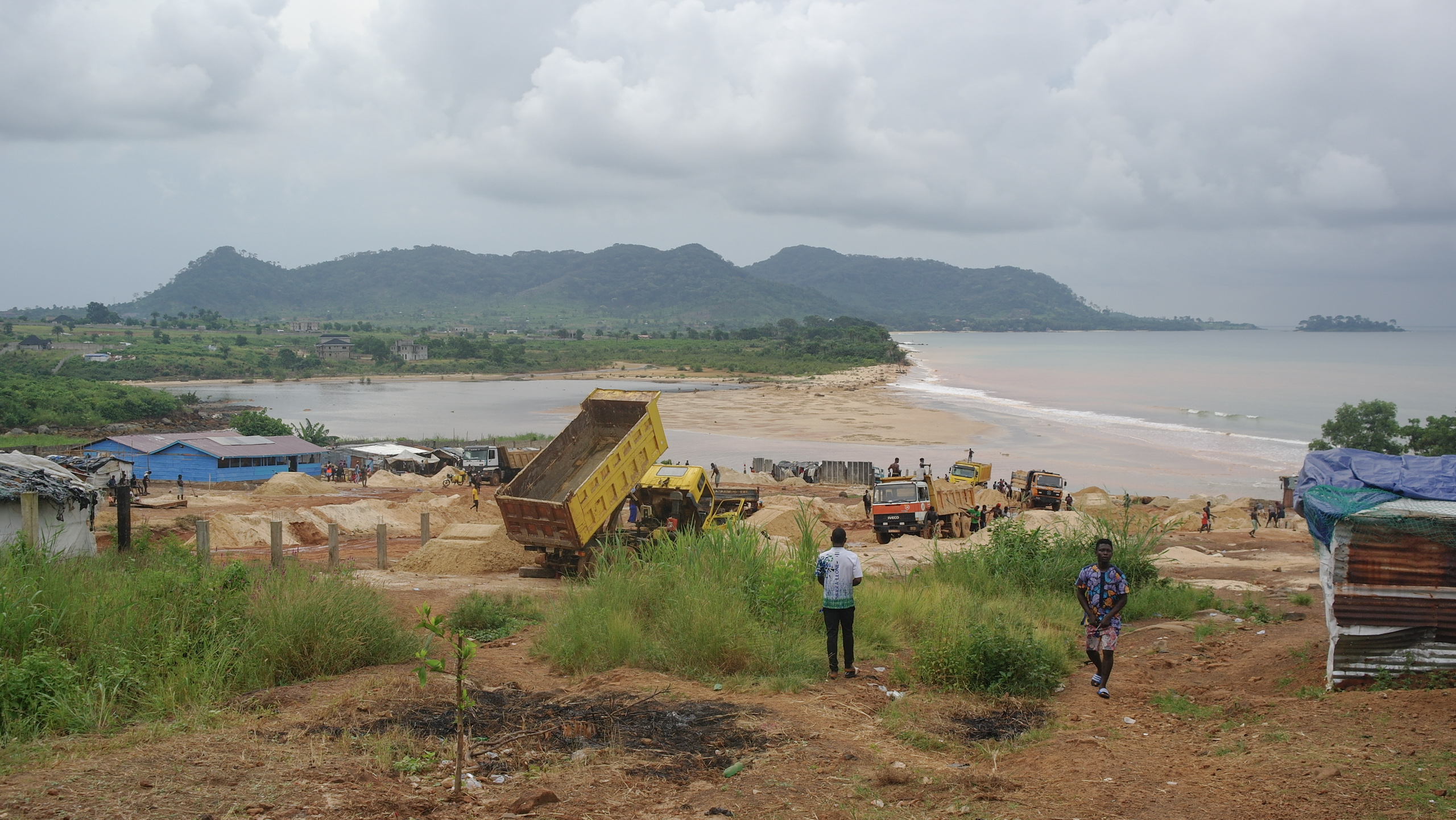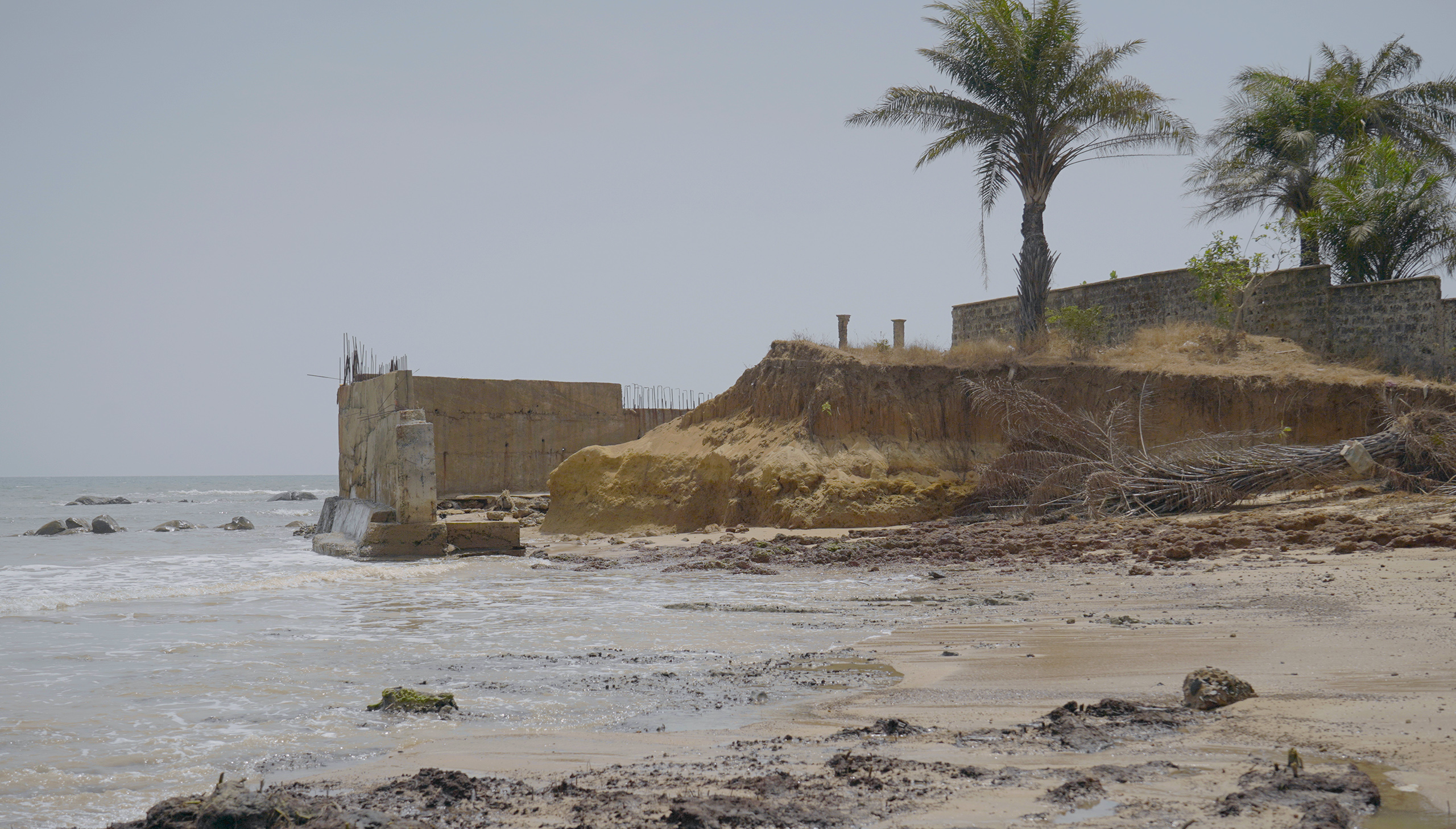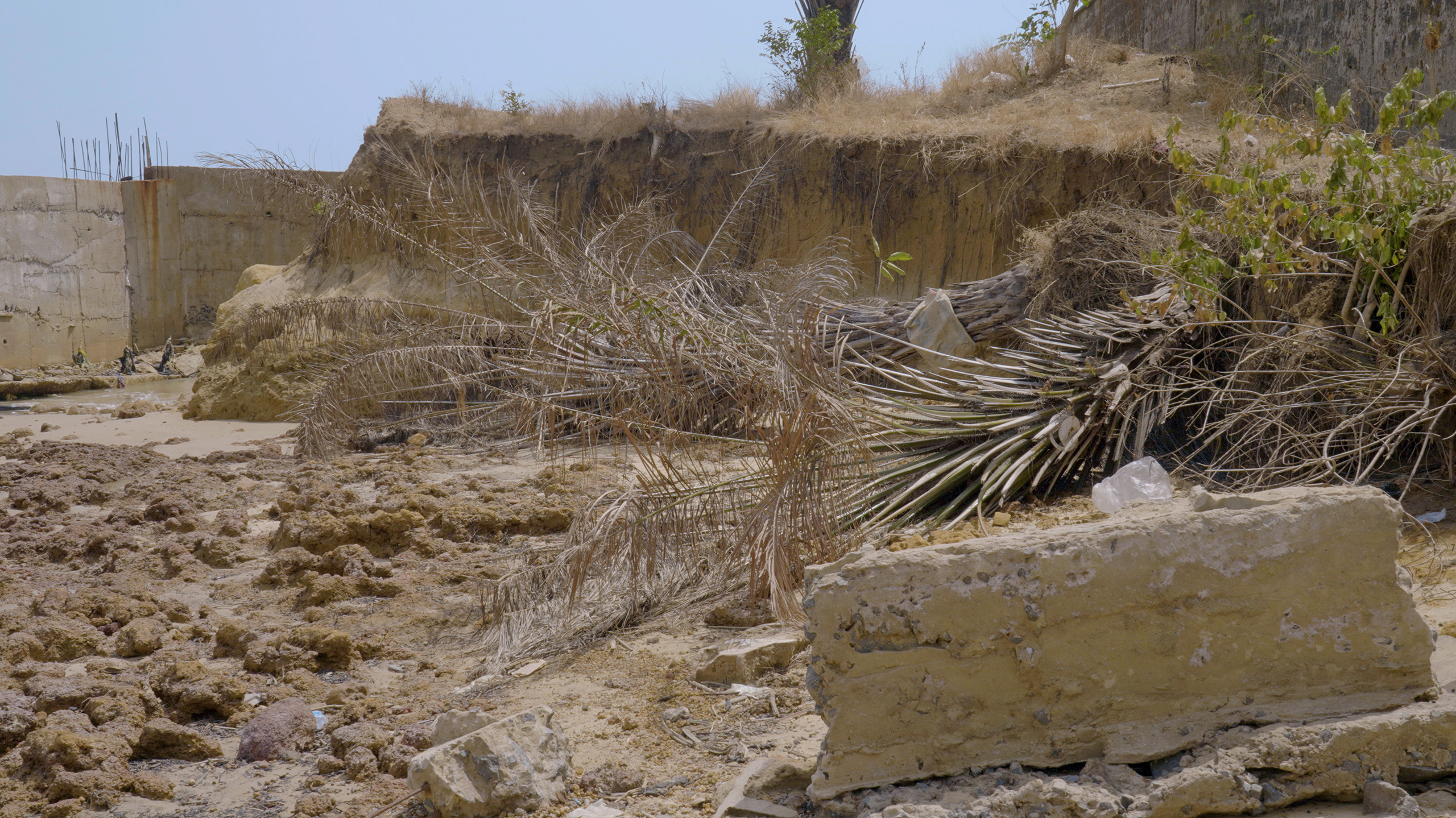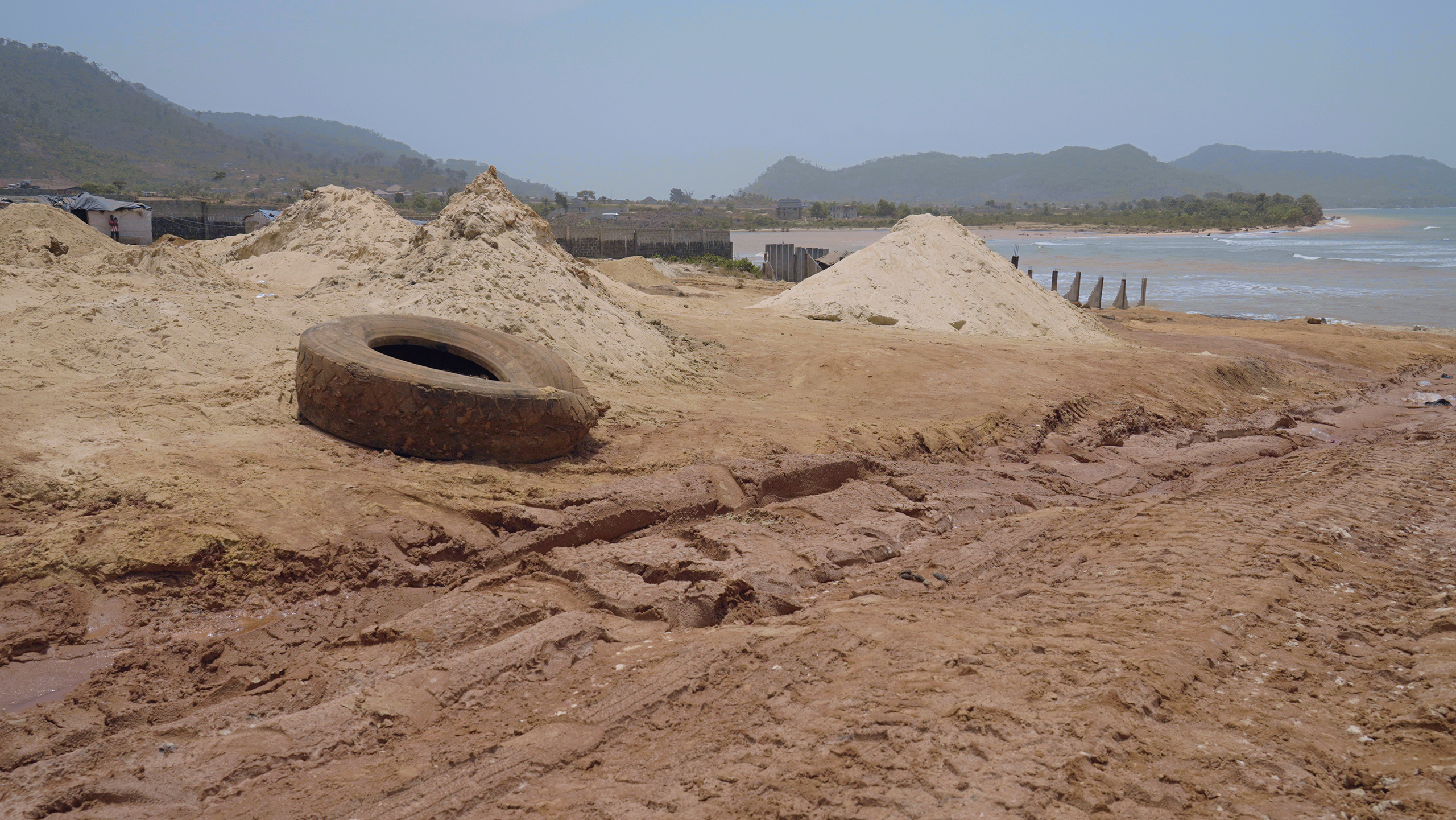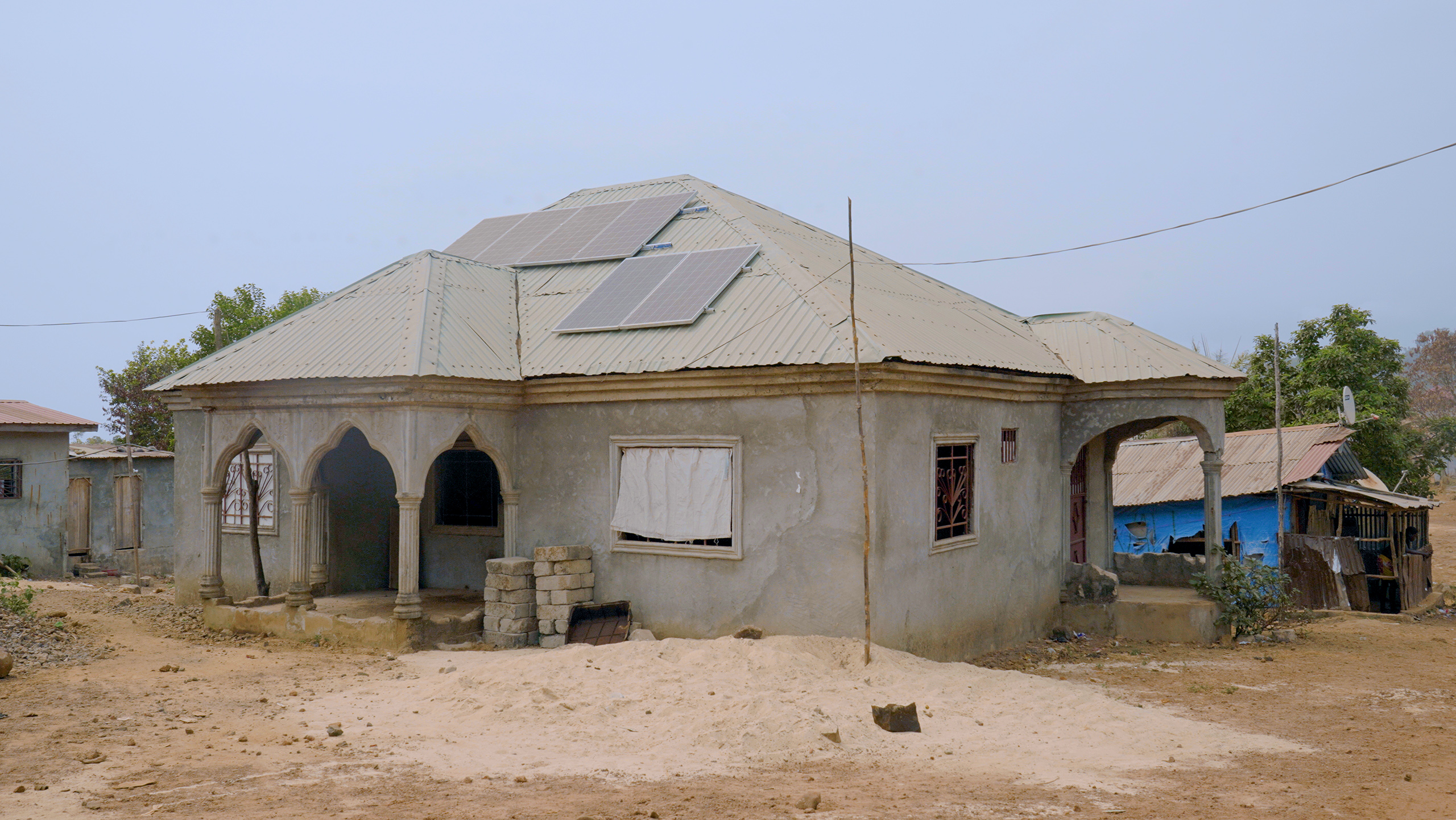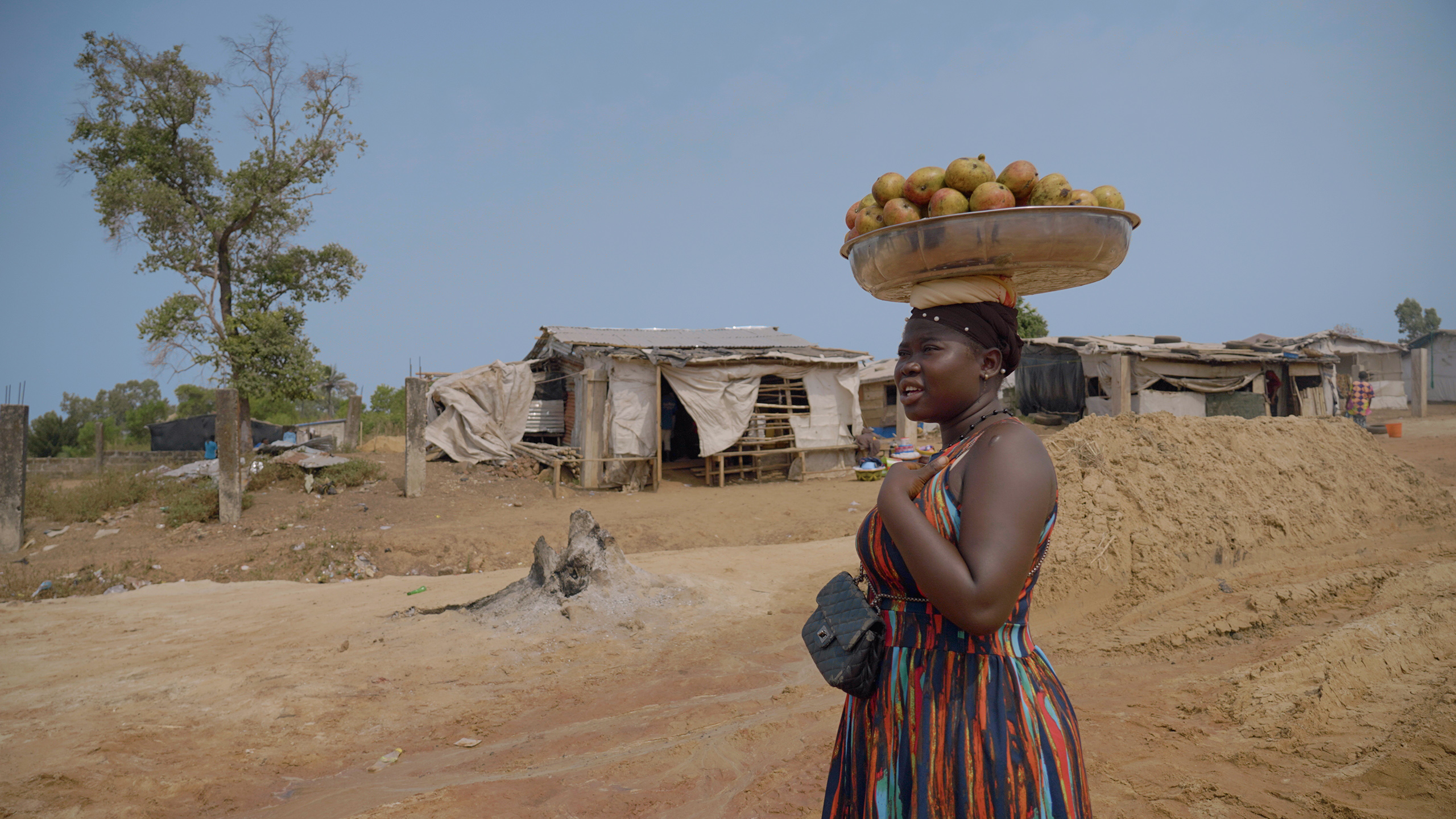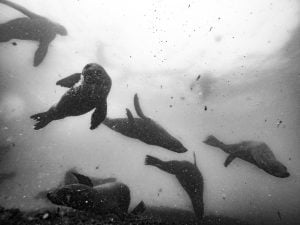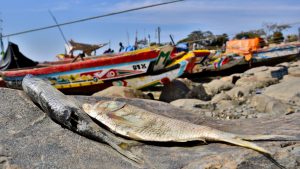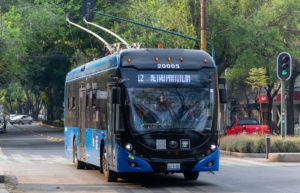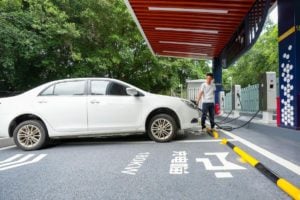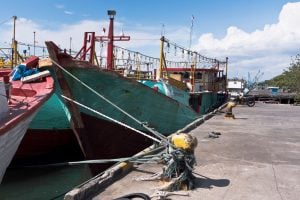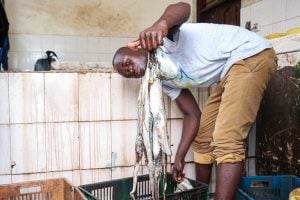Along the coast of the small West African nation of Sierra Leone, the sound of waves breaking against naked rocks could be heard from a distance. But the blaring horns of big trucks and the voices of young men holding shovels overpowers it.
The coast used to be covered in white sandy beaches with large swathes of mangroves and small rivers, which served as breeding ground for fish. Now, desperate youths dig out sand in exchange for money.
“The truck is here. And if you don’t hurry, we might miss our chance on this one,” Samuel James shouts to his friends. They quickly finish up their meals at a makeshift restaurant, pick up the shovels, and walk to the waiting vehicle.
There are about 500 sand miners like James living at John Obey, a coastal village near the capital Freetown. A maximum of 30 are allowed to load a truck, which takes about two hours. Each miner makes roughly 150 to 200 new leones (US$5-10) per day.
“On a day like this, we could make lots of money as long as the trucks keep coming,” James adds.
Sand mining has become a lifeline to many unemployed youths in Sierra Leone. The price of a tonne of sand in the country rose from US$25 in 2012 to $200 in 2021. Most of what is mined goes to a booming local construction sector, and growing demand to feed neighbouring Guinea’s glass manufacturing industry is also driving up prices.
This comes at a great cost for coastal communities and the ecosystems that support them. Villagers say that the mostly regulated extraction is driving away fish and leaving houses and cultural sites to be swallowed by the sea.
A global phenomenon
The demands and controversies around sand extraction are not limited to Sierra Leone.
Globally, sand use has tripled in the last two decades, to reach an estimated 40-50 billion metric tonnes per year, according to the UN Environment Programme. The sector was worth almost $100 billion in 2017 and is projected to be worth about five times that by 2100.
Sand is the most mined material in the world, according to a recent report by the Ocean Risk and Resilience Action Alliance.
A co-author of the report, Jean-Baptiste Jouffray of Stockholm University, tells China Dialogue Ocean: “There have been examples of local scarcities due to intense depletion of sand, but at the global stage, this remains less of a concern than the social and ecological impact of its extraction.”
“Conversations about the impact of sand mining are starting to rise up in the global sustainability agenda, but it’s a lot of call to action and fewer answers,” he adds.
Buried under water
Sand in coastal environments connects land and sea, prevents erosion and buffers extreme weather. As sea levels rise under climate change, coastal communities are facing greater risks from storms and floods, and unregulated sand mining aggravates these vulnerabilities.
Jouffray explains that as mining depletes protective beaches and dunes, coastal towns where mining occurs become more susceptible to heavy flooding from the sea. Businesses and houses that once stretched along beach fronts are being inundated.
In 2022, a flood hit Bureh, a fishing village in south-west Sierra Leone, pouring into a cemetery and washing away coffins. Francis Small, a villager in his early thirties, says: “My father’s grave has been washed away, my grandma’s grave has been washed away, and there is nothing left to show our kids about their ancestors.”
Due to repeated coastal recession and flooding, the beach in Bureh now lies in ruins. Huge logs, iron rods, and other remnants of destroyed structures can be seen littered all over the place. Residents sadly narrate that high tides sometimes wash corpses ashore and leave bones exposed on the sand. The people of Bureh blame the destruction on the mining taking place in nearby John Obey village.
What is happening in Bureh may speak to the dynamic nature of sand. Jouffray says: “Extracting sand from active sand bodies results in changing rates of sand transport that are often crucial for ecosystem functioning and the livelihoods of communities downstream.”
Destroying fishing grounds
Small grew up loving the beach of this quiet community that was once covered in thick mangroves, which decorated the banks of the sea and served as a breeding ground for fish, birds and turtles. There was enough seafood to go around.
“A lot of change has taken place here. I used to fish in the river, but now it’s not easy because the mangroves have been destroyed and the fish cannot breed themselves,” Small says.
The mining disturbs or crushes such habitats, leading to a direct loss of organisms, disruption of food webs, and a decline in ecosystem functions and services.
Donald McCauley, another resident of Bureh, says: “Fishers now get less and less catches, and the people whose livelihoods depend on fishing are struggling. It is ugly to see.” For Small, this means a change in the types of seafood he can eat. “We used to have cockles, crabs and all types of marine species that rely on mangroves and rivers to grow, but now all those have disappeared.”
‘Tourists are not coming like before’
Tourism is also paying a heavy price as sand mining arrives at resort towns in Sierra Leone. Data from the National Tourist Board (NTB) indicates that the Covid pandemic caused a 77.3% drop in tourist arrivals in 2020 compared to 2021, with an estimated decline in revenues from the sector of 63.9%.
The people of Bureh survive partly on tourism. Sand mining destroys the scenery that used to attract visitors. Moses Kabbah, who runs a tourist resort on the main beach of Bureh, says: “If you come here in the rainy season, sometimes you can see corpses washed ashore when the cemetery is flooded. Tourists are not coming like before because it’s very disturbing to see.”
Kabbah relies on tourist visits to raise money for fuel, payment of staff and other running costs, but with things this slow, the long-term survival of his business is unlikely.
Henry Bayoh is head of the climate change unit at the National Tourist Board.
“Sacrificing all the gains of tourism for unregulated sand mining is unacceptable. The tourist board is working with the environment ministry and other government bodies to find a solution to this sand mining problem,” he says.
‘When we do this, the environment suffers’
In the aftermath of the pandemic, a lot of people associated with tourism turned to sand mining. The dwindling fish stocks also prompted fishers to shift towards the practice. Young people know it is hazardous to the environment to mine sand but have little or no alternative means of survival.
John Koroma trucks sand to clients across Freetown. “When I look at our environment now compared to what I used to know growing up, I feel bad because so much destruction has happened,” he says. “When we do this, the environment suffers. But what choice do we have?”
The mayor of Freetown, Yvonne Aki-Sawyerr, told China Dialogue Ocean that the blame for the situation lies on those benefiting from the sand and a lack of political will.
Aki-Sawyerr is a leading voice on environmental protection and climate change in Sierra Leone. She says society is not benefiting from sand mining except for “those selling that sand to the construction industries”.
“This is short-term gain, which is ultimately destroying our peninsula, destroying our beaches and will destroy livelihoods in the long-term,” she adds.
Government must take more responsibility
No international agreement exists to regulate or monitor the mining of ocean sand. Regulation falls to national governments, local authorities or communities, including traditional leaders and citizen committees, Jouffray explains.
In Sierra Leone, there is confusion over which government agency manages the sand mining process. The sector should fall under the supervision of the Environment Protection Agency, but there is no national legislation to regulate it.
Meanwhile, local authorities often rely on income from granting mining permissions. This means more extraction of the resource as authorities pay less attention to the social and environmental consequences. The permitting processes, extraction volumes and pricing mechanisms are not transparent or consistent between districts.
Many African countries lack the tight sand mining regulations and clear rules of mining concessions present in some European countries. Jouffray concludes: “It’s almost a race to the bottom in terms of how much sand can be extracted and how much profit can be made in the short term, with dire consequences for the environment.” Sierra Leone’s environment ministry says it understands the plight of affected communities, but is short of resources.
“We have to really come up with a management institutional arrangement that will help to salvage the coastal communities now under threat,” says Edward Bendu, the ministry’s chief director. “But this takes time and money, and we are constrained in terms of raising funds.”
Bendu says the government is drafting a sand mining policy, which would lay the foundation for better regulation. He also thinks that addressing the lack of opportunities at the grassroots is key to tackling the environmental challenges wrought by sand mining.
“The ministry is currently working on a US$5 million UNDP [United Nations Development Programme] funded project for the sustainable and integrated landscape management of the Western Area Peninsula, and livelihood issues will be a major component,” he says. The proposed project will help to create jobs for the sand miners and reforest depleted mangroves along the coast, he adds.
